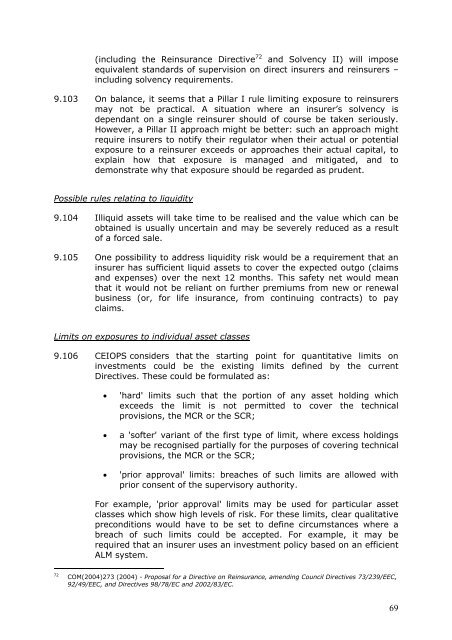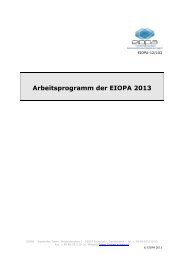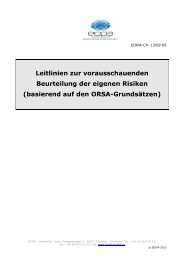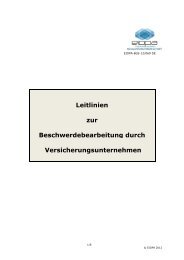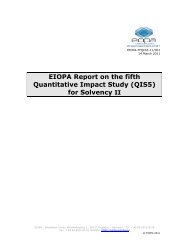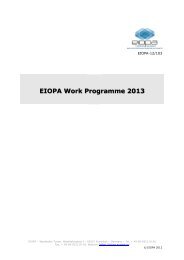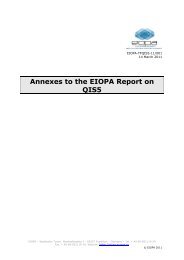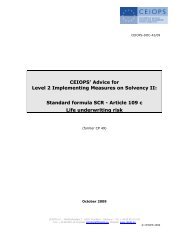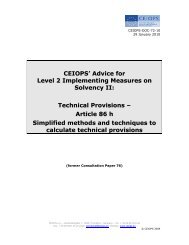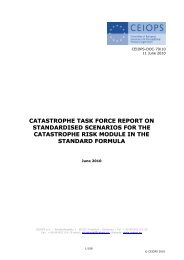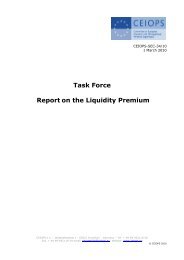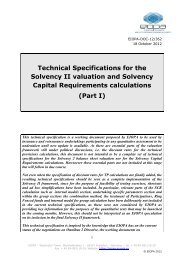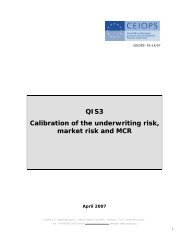Answers to the European Commission on the ... - Eiopa - Europa
Answers to the European Commission on the ... - Eiopa - Europa
Answers to the European Commission on the ... - Eiopa - Europa
Create successful ePaper yourself
Turn your PDF publications into a flip-book with our unique Google optimized e-Paper software.
(including <str<strong>on</strong>g>the</str<strong>on</strong>g> Reinsurance Directive 72 and Solvency II) will impose<br />
equivalent standards of supervisi<strong>on</strong> <strong>on</strong> direct insurers and reinsurers –<br />
including solvency requirements.<br />
9.103 On balance, it seems that a Pillar I rule limiting exposure <str<strong>on</strong>g>to</str<strong>on</strong>g> reinsurers<br />
may not be practical. A situati<strong>on</strong> where an insurer’s solvency is<br />
dependant <strong>on</strong> a single reinsurer should of course be taken seriously.<br />
However, a Pillar II approach might be better: such an approach might<br />
require insurers <str<strong>on</strong>g>to</str<strong>on</strong>g> notify <str<strong>on</strong>g>the</str<strong>on</strong>g>ir regula<str<strong>on</strong>g>to</str<strong>on</strong>g>r when <str<strong>on</strong>g>the</str<strong>on</strong>g>ir actual or potential<br />
exposure <str<strong>on</strong>g>to</str<strong>on</strong>g> a reinsurer exceeds or approaches <str<strong>on</strong>g>the</str<strong>on</strong>g>ir actual capital, <str<strong>on</strong>g>to</str<strong>on</strong>g><br />
explain how that exposure is managed and mitigated, and <str<strong>on</strong>g>to</str<strong>on</strong>g><br />
dem<strong>on</strong>strate why that exposure should be regarded as prudent.<br />
Possible rules relating <str<strong>on</strong>g>to</str<strong>on</strong>g> liquidity<br />
9.104 Illiquid assets will take time <str<strong>on</strong>g>to</str<strong>on</strong>g> be realised and <str<strong>on</strong>g>the</str<strong>on</strong>g> value which can be<br />
obtained is usually uncertain and may be severely reduced as a result<br />
of a forced sale.<br />
9.105 One possibility <str<strong>on</strong>g>to</str<strong>on</strong>g> address liquidity risk would be a requirement that an<br />
insurer has sufficient liquid assets <str<strong>on</strong>g>to</str<strong>on</strong>g> cover <str<strong>on</strong>g>the</str<strong>on</strong>g> expected outgo (claims<br />
and expenses) over <str<strong>on</strong>g>the</str<strong>on</strong>g> next 12 m<strong>on</strong>ths. This safety net would mean<br />
that it would not be reliant <strong>on</strong> fur<str<strong>on</strong>g>the</str<strong>on</strong>g>r premiums from new or renewal<br />
business (or, for life insurance, from c<strong>on</strong>tinuing c<strong>on</strong>tracts) <str<strong>on</strong>g>to</str<strong>on</strong>g> pay<br />
claims.<br />
Limits <strong>on</strong> exposures <str<strong>on</strong>g>to</str<strong>on</strong>g> individual asset classes<br />
9.106 CEIOPS c<strong>on</strong>siders that <str<strong>on</strong>g>the</str<strong>on</strong>g> starting point for quantitative limits <strong>on</strong><br />
investments could be <str<strong>on</strong>g>the</str<strong>on</strong>g> existing limits defined by <str<strong>on</strong>g>the</str<strong>on</strong>g> current<br />
Directives. These could be formulated as:<br />
• 'hard' limits such that <str<strong>on</strong>g>the</str<strong>on</strong>g> porti<strong>on</strong> of any asset holding which<br />
exceeds <str<strong>on</strong>g>the</str<strong>on</strong>g> limit is not permitted <str<strong>on</strong>g>to</str<strong>on</strong>g> cover <str<strong>on</strong>g>the</str<strong>on</strong>g> technical<br />
provisi<strong>on</strong>s, <str<strong>on</strong>g>the</str<strong>on</strong>g> MCR or <str<strong>on</strong>g>the</str<strong>on</strong>g> SCR;<br />
• a 'softer' variant of <str<strong>on</strong>g>the</str<strong>on</strong>g> first type of limit, where excess holdings<br />
may be recognised partially for <str<strong>on</strong>g>the</str<strong>on</strong>g> purposes of covering technical<br />
provisi<strong>on</strong>s, <str<strong>on</strong>g>the</str<strong>on</strong>g> MCR or <str<strong>on</strong>g>the</str<strong>on</strong>g> SCR;<br />
• 'prior approval' limits: breaches of such limits are allowed with<br />
prior c<strong>on</strong>sent of <str<strong>on</strong>g>the</str<strong>on</strong>g> supervisory authority.<br />
For example, 'prior approval' limits may be used for particular asset<br />
classes which show high levels of risk. For <str<strong>on</strong>g>the</str<strong>on</strong>g>se limits, clear qualitative<br />
prec<strong>on</strong>diti<strong>on</strong>s would have <str<strong>on</strong>g>to</str<strong>on</strong>g> be set <str<strong>on</strong>g>to</str<strong>on</strong>g> define circumstances where a<br />
breach of such limits could be accepted. For example, it may be<br />
required that an insurer uses an investment policy based <strong>on</strong> an efficient<br />
ALM system.<br />
72 COM(2004)273 (2004) - Proposal for a Directive <strong>on</strong> Reinsurance, amending Council Directives 73/239/EEC,<br />
92/49/EEC, and Directives 98/78/EC and 2002/83/EC.<br />
69


